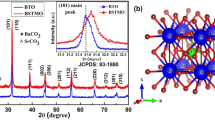Abstract
BaTiO3 forms an extensive range of solid solutions with Nd2O3 by means of the double substitution mechanism: Ba + Ti ⇒ 2Nd, as shown by both a phase diagram study and Rietveld refinement using powder neutron diffraction data. The solid solutions have the general formula Ba1-xTi1-xNd2xO3Odxd0.12 at 1300°C and 1300°C and O dxd at 1400°C. With increasing x, the symmetry changes from tetragonal to cubic at x∼ 0.09. The sharp permittivity maximum at ∼127°C in stoichiometric BaTiO3 broadens very rapidly with increasing x and gradually moves to lower temperatures: this appears to be because, with substitution of Nd onto Ti sites, formation of the ferroelectric domains is increasingly difficult because of the presence of dipole-inactive Nd3+ ions on the Ti sites.
Similar content being viewed by others
References
F.D. Morrison, D.C. Sinclair, J.M.S. Skakle, and A.R. West, J. Am. Ceram. Soc., 81, 1957 (1998).
G.H. Jonker and E.E. Havinga, Mat. Res. Bull., 17, 345 (1982).
M. Kahn, J. Am. Ceram. Soc., 54, 455 (1971).
J.P. Bonsack, Am. Ceram. Soc. Bull., 50, 488 (1971).
K.S. Mazdiyasni and L.M. Borwn, J. Am. Ceram. Soc., 54, 539 (1971).
N.M. Molokhia, M.A.A. Issa, and S.A. Nasser, J. Am. Ceram. Soc., 67, 289 (1984).
K.S. Mazdiyasni, Am. Ceram. Soc. Bull., 63, 591 (1984).
P. Murugaraj, T.R.N. Kutty, and M.S. Rao, J. Mat. Sci., 21, 3521 (1986).
C. Zheng and A.R. West, Brit. Ceram. Proc., 49, 247 (1992).
T.R.N. Kutty and P. Murugaraj, J. Mat. Sci., 22, 3652 (1989).
A.S. Shaikh and R.W. Vest, J. Am. Ceram. Soc., 69, 689 (1986).
R.I. Smith and S. Hull, Report RAL-TR–97–038, Rutherford Appleton Laboratory (1997).
W.I.F. David, R.M. Ibberson, and J.C. Mathewman, Report RAL–92–032, Rutherford Appleton Laboratory (1992).
G. Goodman, J. Am. Ceram. Soc., 43, 105 (1960).
D. Barb, E. Barbulescu, and A. Barbulescu, Phys. Status. Solidi, 74a, 79 (1982).
D. Hennings, A. Schnell, and G. Simon, J. Am. Ceram. Soc., 65, 539 (1982).
H-Y. Lu, J-S. Bow, and W-H. Deng, J. Am. Ceram. Soc., 73, 3562 (1990).
K. Takada, E. Chang, and D.M. Smyth, Adv. in Ceramics, 19, 147 (1987).
Author information
Authors and Affiliations
Rights and permissions
About this article
Cite this article
Hirose, N., Skakle, J. & West, A. Doping Mechanism and Permittivity Correlations in Nd-Doped BaTiO3 . Journal of Electroceramics 3, 233–238 (1999). https://doi.org/10.1023/A:1009973300039
Issue Date:
DOI: https://doi.org/10.1023/A:1009973300039



